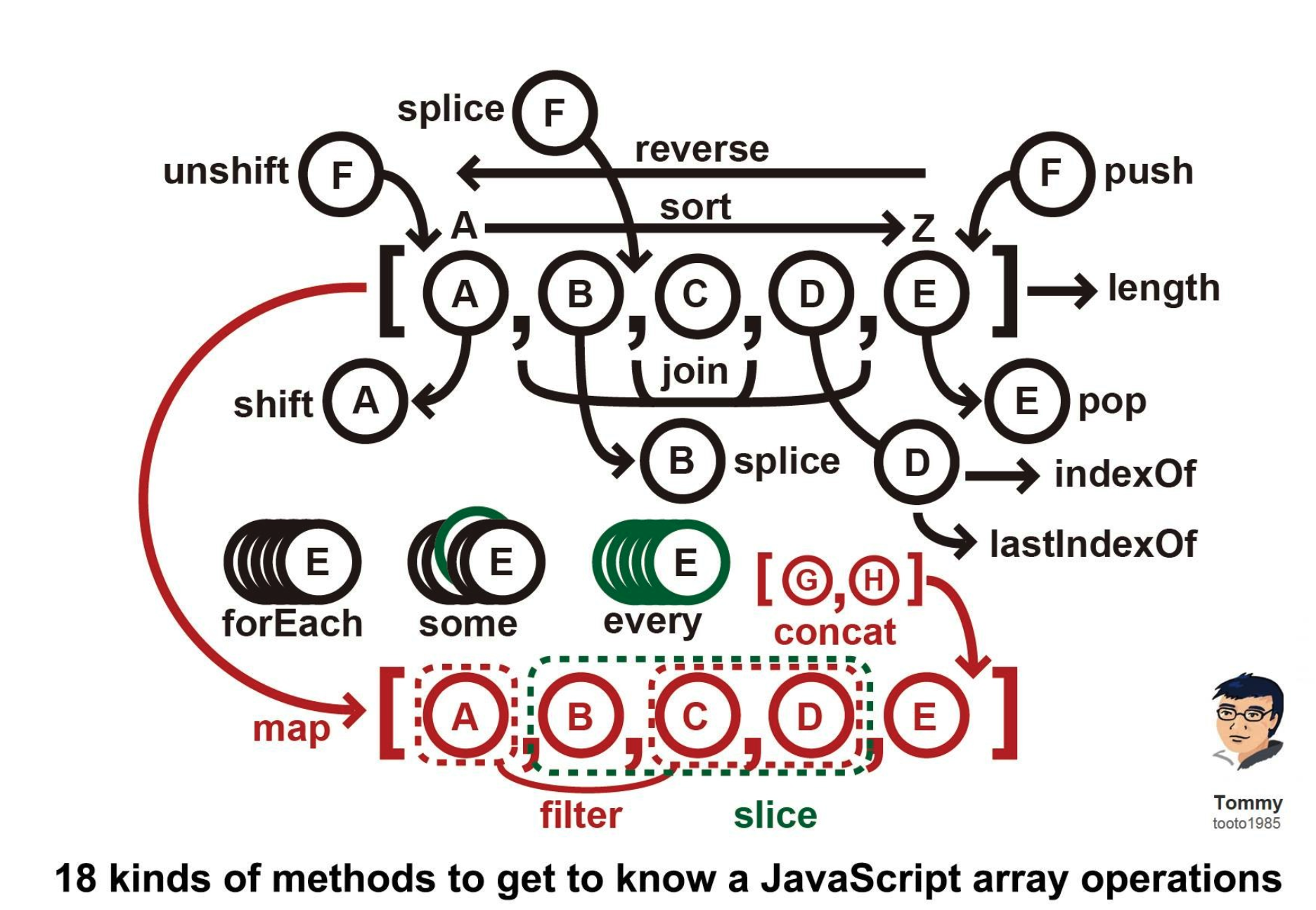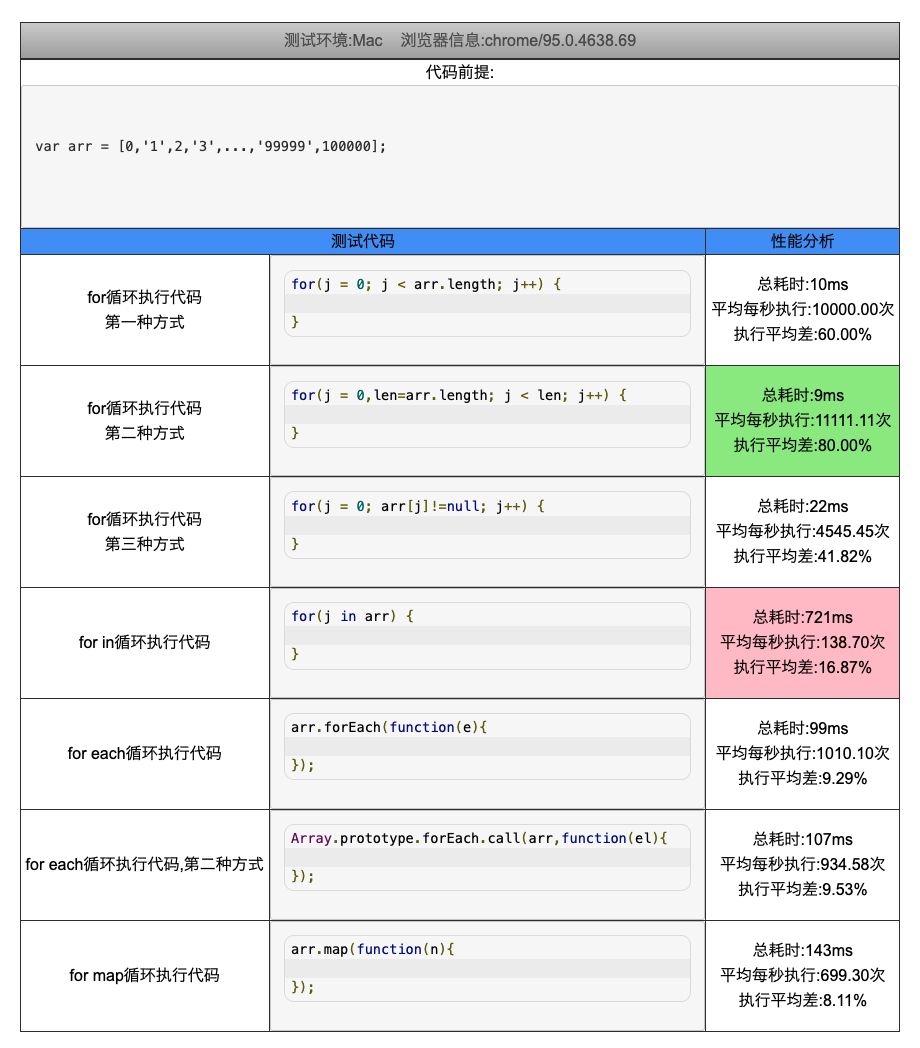preface
This paper describes several array traversal methods commonly used in JS and performance analysis and comparison.
If this article helps you, ❤️ Follow + like ❤️ Encourage the author, the official account and the first time to get the latest articles.

Array method
JavaScript has provided many array methods up to now. The following figure covers most of the array methods. This article mainly talks about the array traversal methods and their respective performance. There are so many methods. How to select the method with the best performance is very helpful to our development.

Array traversal method
for
The standard for loop statement is also the most traditional loop statement
var arr = [1,2,3,4,5]
for(var i=0;i<arr.length;i++){
console.log(arr[i])
}
The simplest traversal method is also the most frequently used, with good performance, but it can also be optimized
Optimized for loop statement
var arr = [1,2,3,4,5]
for(var i=0,len=arr.length;i<len;i++){
console.log(arr[i])
}
Use temporary variables to cache the length to avoid repeatedly obtaining the array length, especially when the array length is large.
This method is basically the highest performance of all loop traversal methods
forEach
Common forEach
Run the given function on each element in the array without return value. It is often used to traverse the elements
var arr5 = [10,20,30]
var result5 = arr5.forEach((item,index,arr)=>{
console.log(item)
})
console.log(result5)
/*
10
20
30
undefined The method has no return value
*/
Array's own foreach loop is frequently used. In fact, its performance is weaker than that of ordinary for loop
Prototype forEach
Because foreach comes with Array type, some non Array types cannot be used directly (such as NodeList), so this variant is available. Using this variant can make similar arrays have foreach function.
const nodes = document.querySelectorAll('div')
Array.prototype.forEach.call(nodes,(item,index,arr)=>{
console.log(item)
})
The actual performance is weaker than ordinary foreach
for...in
Traverse the division of an object in any order Symbol Outside enumerable Properties, including inherited enumerable properties.
It is commonly used to traverse objects, including the names of non integer types and the attributes on the inherited prototype chain. For example, objects created by Array and Object using built-in constructors will inherit from the non enumerable properties of Object.prototype and String.prototype, so they cannot be traversed
var arr = [1,2,3,4,5]
for(var i in arr){
console.log(i,arr[i])
} //Here i is the object attribute, that is, the subscript of the array
/**
0 1
1 2
2 3
3 4
4 5 **/
Most people like this method, but its performance is not very good
for...of (cannot traverse object)
Create an iteration loop on the iteratable object (with iterator interface) (Array, Map, Set, String, arguments), call the custom iteration hook, and execute the statement for the value of each different attribute. The object cannot be traversed
let arr=["front end","Nanjiu","ssss"];
for (let item of arr){
console.log(item)
}
//Front end Nanjiu ssss
//Traversal object
let person={name:"Nanjiu",age:18,city:"Shanghai"}
for (let item of person){
console.log(item)
}
// We found it impossible. We can use it with Object.keys
for(let item of Object.keys(person)){
console.log(person[item])
}
// Nanjiu 18 Shanghai
This method is used in es6. Its performance is better than forin, but it is still not as good as ordinary for loops
map
map: you can only traverse the array without interruption. The return value is the modified array.
let arr=[1,2,3];
const res = arr.map(item=>{
return res+1
})
console.log(res) //[2,3,4]
console.log(arr) // [1,2,3]
every
Run the given function for each item in the array. If the function returns true for each item, the function returns true
var arr = [10,30,25,64,18,3,9]
var result = arr.every((item,index,arr)=>{
return item>3
})
console.log(result) //false
some
Run the given function for each item in the array. If one item of the function returns true, it will return true, and all items return false before returning false
var arr2 = [10,20,32,45,36,94,75]
var result2 = arr2.some((item,index,arr)=>{
return item<10
})
console.log(result2) //false
reduce
The reduce() method executes a reducer function (executed in ascending order) provided by you for each element in the array, and summarizes the results into a single return value
const array = [1,2,3,4] const reducer = (accumulator, currentValue) => accumulator + currentValue; // 1 + 2 + 3 + 4 console.log(array1.reduce(reducer));
filter
Running a given function on each item in the array returns an array of items that satisfy the function
// filter returns a new array of array items that meet the requirements
var arr3 = [3,6,7,12,20,64,35]
var result3 = arr3.filter((item,index,arr)=>{
return item > 3
})
console.log(result3) //[6,7,12,20,64,35]
performance testing
Tool test
Test with tools performance analysis The results are shown in the figure below

Manual test
We can also test with our own code:
//Test function
function clecTime(fn,fnName){
const start = new Date().getTime()
if(fn) fn()
const end = new Date().getTime()
console.log(`${fnName}Execution time:${end-start}ms`)
}
function forfn(){
let a = []
for(var i=0;i<arr.length;i++){
// console.log(i)
a.push(arr[i])
}
}
clecTime(forfn, 'for') //for execution time: 106ms
function forlenfn(){
let a = []
for(var i=0,len=arr.length;i<len;i++){
a.push(arr[i])
}
}
clecTime(forlenfn, 'for len') //for len execution time: 95ms
function forEachfn(){
let a = []
arr.forEach(item=>{
a.push[item]
})
}
clecTime(forEachfn, 'forEach') //forEach execution time: 201ms
function forinfn(){
let a = []
for(var i in arr){
a.push(arr[i])
}
}
clecTime(forinfn, 'forin') //forin execution time: 2584ms (outrageous)
function foroffn(){
let a = []
for(var i of arr){
a.push(i)
}
}
clecTime(foroffn, 'forof') //forof execution time: 221ms
// ... others can be tested by themselves
Result analysis
Through the tool and manual test, it is found that the results are basically the same. The speed of array traversal of each method: the traditional for loop is the fastest and for in is the slowest
for-len > for > for-of > forEach > map > for-in
Suggested usage of javascript native traversal method:
- Traversing an array with a for loop
- Traversing objects with for...in
- Traversing class array objects with for...of (ES6)
- Get the collection of object attribute names with Object.keys()
Why is for... in slow?
Because the for...in syntax is the first JavaScript statement that can iterate over object keys, looping over object keys ({}) is different from looping over arrays ([]), and the engine will perform some extra work to track the iterated properties. Therefore, it is not recommended to use for...in to traverse the array
Recommended reading
These browser interview questions, see how many you can answer?
This time it takes you through front-end local storage
Interviewer: tell me the difference between front-end routing and back-end routing
Prototype and prototype chain of JavaScript
Javascript deep scope and closure
this points to call,apply,bind
I think the article is good. You can praise it_ In addition, please pay attention to message exchange ~